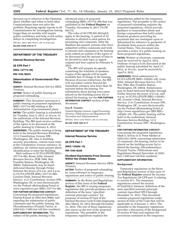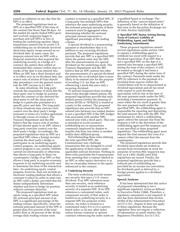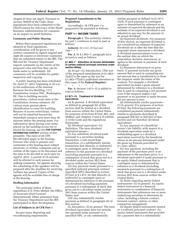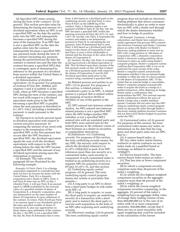Datasheet 搜索 > 热敏电阻 > VISHAY(威世) > NTCS0603E3202JLT 数据手册 > NTCS0603E3202JLT 其他数据使用手册 6/9 页

 器件3D模型
器件3D模型¥ 1.156
NTCS0603E3202JLT 其他数据使用手册 - VISHAY(威世)
制造商:
VISHAY(威世)
分类:
热敏电阻
封装:
0603
描述:
温度传感器
Pictures:
3D模型
符号图
焊盘图
引脚图
产品图
NTCS0603E3202JLT数据手册
Page:
of 9 Go
若手册格式错乱,请下载阅览PDF原文件

3207
Federal Register / Vol. 77, No. 14 / Monday, January 23, 2012 / Proposed Rules
(d) Specified NPC status arising
during the term of the contract—(1) In
general. This section provides rules for
determining the timing and amount of a
dividend equivalent when an NPC is not
a specified NPC on the date the parties
enter into the NPC and subsequently
becomes a specified NPC during the
term of the transaction. If an NPC that
is not a specified NPC on the date the
parties enter into the contract
subsequently becomes a specified NPC,
any payment made during the term of
the contract (including any payment
during the period between the date the
contract is entered into and the date the
contract becomes a specified NPC) that
is contingent upon or determined by
reference to the payment of a dividend
from sources within the United States is
a dividend equivalent.
(2) Determination of dividend
equivalent—(i) In general. For purposes
of sections 871(a), 881, 4948(a), and
chapters 3 and 4 of subtitle A of the
Code, when an NPC becomes a specified
NPC during the term of the contract, any
tax owed with respect to a dividend
equivalent made prior to the NPC
becoming a specified NPC is payable
when the next payment as described in
§ 1.1871–15(c), including a termination
payment, is made pursuant to the
contract.
(ii) Payment to include amount equal
to dividend equivalent with respect to
current and prior payments. In
computing the amount of tax owed with
respect to the termination of the
specified NPC or the first payment that
occurs after the NPC becomes a
specified NPC, the dividend equivalent
equals the sum of all the dividend
equivalents with respect to the NPC
arising before the date the NPC became
a specified NPC and the amount of any
dividend equivalent arising upon the
termination or payment.
(3) Example. The rules of this
paragraph (d) are illustrated by the
following example:
Example. (i) Facts. Party A is a foreign
corporation organized in a jurisdiction that
does not have an income tax treaty with the
United States. Party B is a domestic
corporation and a dealer in NPCs. Party A
and Party B enter into an NPC on Day 1
whereby Party A will pay Party B an amount
equal to LIBOR multiplied by the notional
value of a specified number of shares of
Corporation X, a domestic corporation, plus
any depreciation on the same number of
shares of Corporation X upon settlement of
the contract. In return, Party B will pay Party
A an amount equal to any dividends paid on
the same specified number of shares of
Corporation X, plus any appreciation on
those shares upon settlement of the contract.
On Day 1, the NPC is not a specified NPC.
On Day 30, Party B determines that it owes
Party A $25 based on a dividend paid on the
underlying security and that Party A owes
Party B $125 on the LIBOR leg of the
contract. Party A therefore makes a net
payment of $100 to Party B. On Day 120, the
NPC becomes a specified NPC within the
meaning of section 871(m), §§ 1.871–15, and
1.871–16. On Day 120, Party A terminates the
contract and makes a net termination
payment to Party B. In calculating the net
payment, Party B determined that it owes
Party A $25 based on a dividend paid with
respect to the shares of Corporation X and
that Party A owes it $125 attributable to
interest and the decrease in the value of the
shares of Corporation X.
(ii) Analysis. On Day 120, Party A is treated
as having received a dividend equivalent of
$50. This dividend equivalent consists of the
$25 payment made on Day 120 that is based
on a dividend payment made with respect to
the shares of Corporation X and the $25
dividend equivalent made prior to the
contract being considered a specified NPC.
(e) Related persons and parties to an
NPC—(1) In general. For purposes of
this section, a related person is
considered a party to an NPC. A related
person is a person that is related within
the meaning of section 267(b) or
707(b)(1) to one of the parties to the
NPC.
(2) NPC entered into between related
dealers. An NPC entered into between
related persons is not a specified NPC
when the NPC hedges another NPC
(whether or not a specified NPC)
entered into with an unrelated party and
both NPCs were entered into by the
related persons in the ordinary course of
their business as a dealer in securities
or commodities derivatives.
(f) Definitions—(1) Underlying
security. For purposes of this section,
the term underlying security means, for
any NPC, the security with respect to
which the dividend referred to in
§ 1.871–15(b)(1)(ii) is paid. If an NPC
references more than one security or a
customized index, each security or
component of such customized index is
treated as an underlying security in a
separate NPC for purposes of section
871(m), § 1.871–15, and this section.
(2) Underlying equity control
program—(i) In general. The term
underlying equity control program
means any system or procedure that
permits—
(A) A long party to an NPC to direct
how a short party hedges its risk under
such NPC; or
(B) A long party to acquire, or cause
the short party to acquire, an underlying
security in a transaction with a short
party and to instruct the short party to
execute such acquisition in the form of
an NPC after acquiring such underlying
security.
(ii) Electronic trading—(A) In general.
The term underlying equity control
program does not include an electronic
trading platform that allows customers
electronically to place an order to enter
into an NPC with a dealer and through
which the dealer determines whether
and how to hedge its position.
(B) Example. Customer, a foreign
corporation, and Dealer have entered into a
master agreement that governs NPCs entered
into between Customer and Dealer. Customer
places an order with Dealer via Dealer’s
electronic trading platform to enter into an
NPC with a long position in 100 shares of
Corporation ABC, a domestic corporation.
Dealer’s electronic trading platform allows
Customer to place an order using Dealer’s
computer program. Dealer’s computer system
confirms that Corporation ABC is not on its
restricted list upon receipt of the order.
Dealer’s computer system automatically
determines whether it has an internal hedge
available to offset the risk of a short position
in 100 shares of Corporation ABC. To the
extent that an internal hedge is unavailable,
Dealer’s computer program automatically
seeks to acquire the stock as a hedge in a
market transaction. After obtaining its hedge,
Dealer sends a confirmation that
memorializes the NPC. The notional amount
on the confirmation reflects the price of
Dealer’s hedge plus a market standard
spread. Customer did not enter into the NPC
using an underlying equity control program
solely by placing the order through Dealer’s
electronic trading platform because Customer
did not direct how Dealer hedged its position
under the NPC.
(3) Customized index—(i) In general.
For purposes of this section, the term
customized index means any index, as
determined on the date that the long
party and short party enter into an NPC,
that is—
(A) A narrow-based index; or
(B) Any other index unless futures
contracts or option contracts on such
index trade on a qualified board or
exchange, as defined in section
1256(g)(7).
(ii) Narrow-based index. The term
narrow-based index means an index—
(A) That has nine or fewer component
securities;
(B) In which a component security
comprises more than 30 percent of the
index’s weighting;
(C) In which the five highest weighted
component securities in the aggregate
comprise more than 60 percent of the
index’s weighting; or
(D) In which the lowest weighted
component securities comprising, in the
aggregate, 25 percent of the index’s
weighting have an aggregate dollar value
of average daily trading volume of less
than $50,000,000 (or in the case of an
index with 15 or more component
securities, $30,000,000), except that if
there are two or more securities with
equal weighting that could be included
in the calculation of the lowest
VerDate Mar<15>2010 16:33 Jan 20, 2012 Jkt 226001 PO 00000 Frm 00049 Fmt 4702 Sfmt 4702 E:\FR\FM\23JAP1.SGM 23JAP1
srobinson on DSK4SPTVN1PROD with PROPOSALS
器件 Datasheet 文档搜索
AiEMA 数据库涵盖高达 72,405,303 个元件的数据手册,每天更新 5,000 多个 PDF 文件






